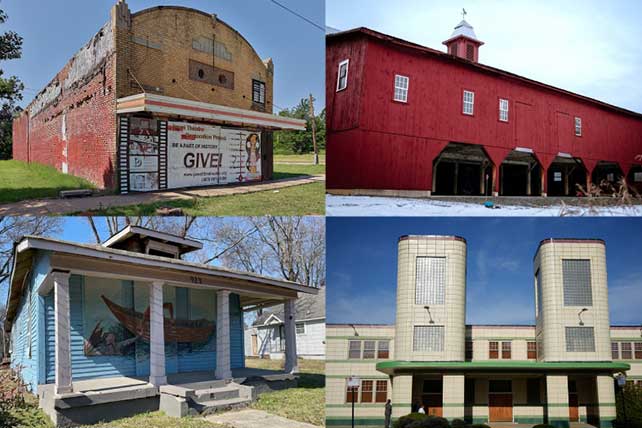(RNS) — Black churches, cemeteries and seminaries with ties to African American history are among 24 cultural sites across the country receiving grants from the National Trust for Historic Preservation, in a $3 million total investment.
The grants, awarded through the trust’s African American Cultural Heritage Action Fund and announced on Tuesday (July 22), aim to support historical sites of “Black American joy, resilience, innovation, and activism” in their preservation efforts, according to a news release.
The grants are “crucial to keeping our nation’s history alive,” said Brent Leggs, director of the action fund and senior vice president at the National Trust, in the release. “We hope this investment will further empower these communities to be leaders in this important effort.”
Since its creation in 2017, the action fund has raised over $150 million to support 378 projects across the country. The fund awards grants through various programs, including its National Grant Program, Preserving Black Churches, Conserving Black Modernism and the Descendants and Family Stewardship Initiative. The fund is managed in collaboration with arts professionals, academics, philanthropists and preservationists.
The action fund said it hopes to reaffirm the importance of promoting Black history through funding the projects. It also said it worries proposed federal budget cuts to national preservation programs will “destabilize the infrastructure that helps communities preserve and interpret their stories — particularly those that have long been excluded from dominant historical narratives.”
Three faith-related projects are receiving funding through the Conserving Black Modernism program, now in its third cohort. The program promotes the work of underrecognized 20th-century African American architects and designers and celebrates their contributions to the modernist movement.
The Founder’s Church of Religious Science in Los Angeles, founded by New Thought teacher Ernest Holmes, will receive $150,000 to finance its accessibility and interpretation plans. The church’s reinforced concrete building was designed by Paul R. Williams, the first Black member of the American Institute of Architects, in 1960.
First Church of Deliverance, a nondenominational Black church in Chicago, will receive $150,000 to fund its first preservation plans, which will include renovations to its sanctuary, community center, day care and children’s church. Its building, a repurposed hat factory covered in glazed terracotta tiles, was redesigned in 1939 by Walter T. Bailey, Illinois’ first licensed Black architect.
And the Interdenominational Theological Center, a Christian Africentric ecumenical theological seminary campus in Atlanta, will receive $150,000 for an audit of its administration building’s structures, the oldest on the campus. The center is also using the money to document the influence of the center’s architect, Edward C. Miller, the first Black architect in the state of Georgia, who completed the building in 1961.
The action fund also announced that it invested $5.2 million with the Mellon Foundation as part of a Descendant and Family Stewardship program to support descendant- and family-led organizations in managing their historic places.
Descendants of Bibbtown, a 19th-century freedmen’s community established in Russellville, Kentucky, are receiving $200,000 through the Descendant and Family Stewardship program to support renovations of Bibbtown’s church and cemetery. The community was named after Richard Bibb, a Revolutionary War major and enslaver, who willed 1,200 acres of land to 65 former slaves after he died in 1839. Their descendants founded the SEEK Museum in Bibb’s former plantation house.
Other recipients include New York’s Apollo Theater; Houston’s first African American cemetery; the house of Chicago blues musician Muddy Waters; and Tennessee’s Highlander Research and Education Center, where Martin Luther King Jr. and Rosa Parks trained.
Additional grant recipients include:
Apollo Theater, Harlem, New York City
Berry College African American Cemeteries, Mount Berry, Georgia
Gibbs Cottage, Tallahassee, Florida
Historic Brooklyn, Brooklyn, Illinois
Colored Knight of Pythias, Indianapolis
Town of Glendora, Glendora, Mississippi
Lewis H. Latimer House Museum, Flushing, New York
Sylvester Manor Educational Farm, Shelter Island, New York
Jewel Theater, Oklahoma City
Letitia Carson Legacy Project, Corvallis, Oregon
Tom Lee House: Klondike Cultural Center, Memphis, Tennessee
Woodville School, Gloucester, Virginia
Muddy Waters Mojo Museum, Chicago
The Custom House, Chestertown, Maryland
Highlander Research and Education Center, New Market, Tennessee
Olivewood Cemetery, Houston
Clemmons Family Farm, Charlotte, Vermont
Dr. James and Janie Washington Cultural Center, Seattle
2500 New Hackensack, Poughkeepsie, New York
McKenzie Hall, Eugene, Oregon
This article originally appeared here.

